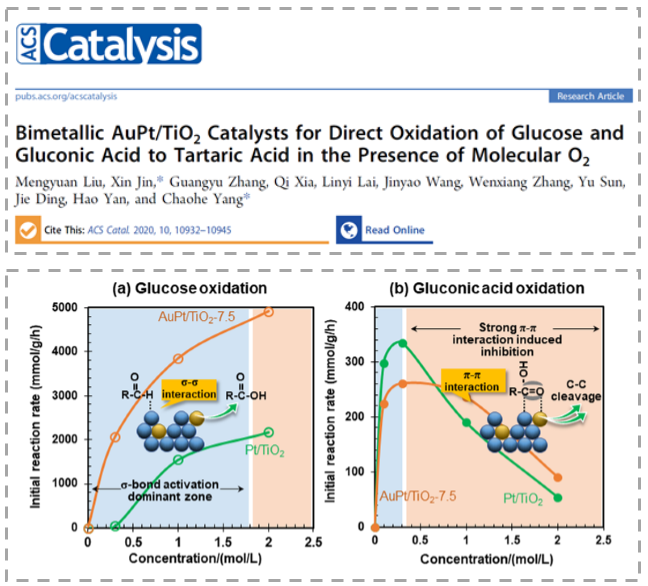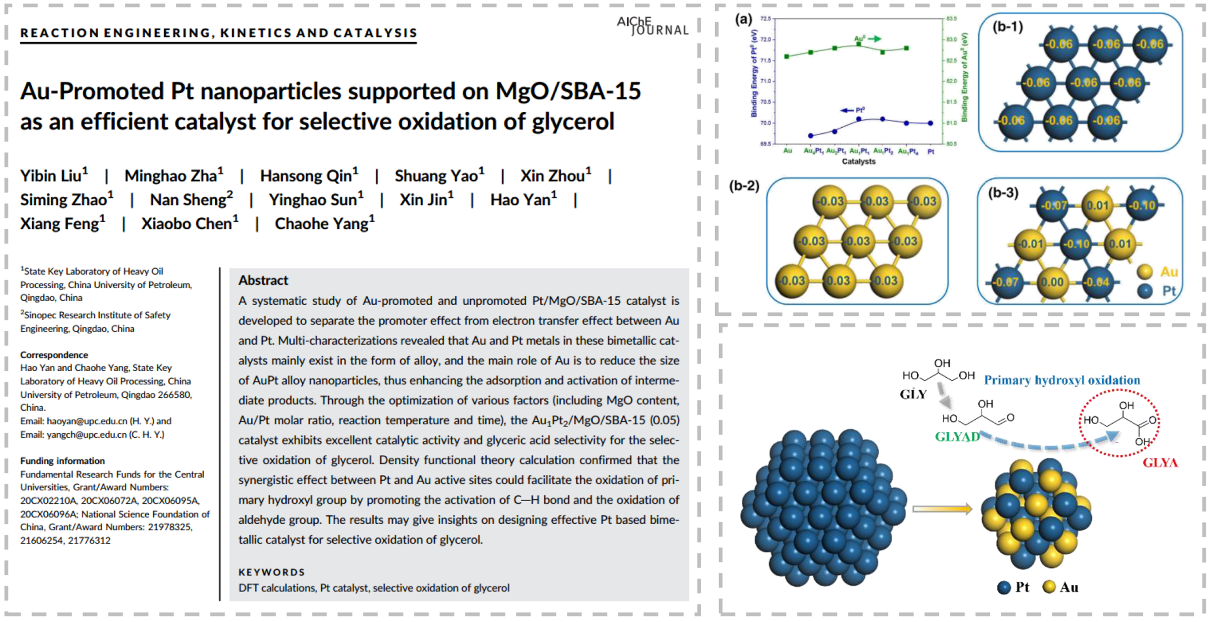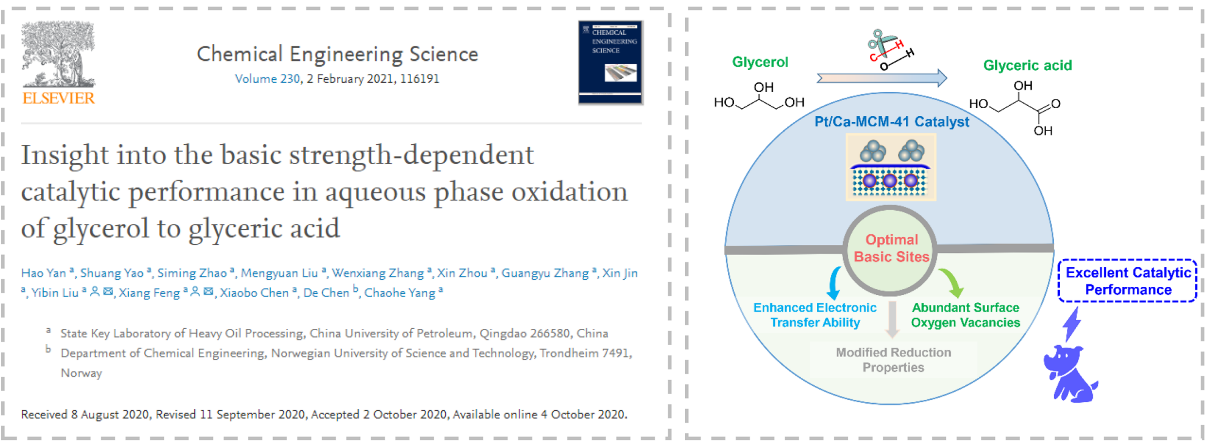Recently, a series of progress in the catalytic oxidation of bio-based polyols was acquired by catalytic reaction engineering team in our university. These research results have been published in top journals of ACS Catalysis, Applied Catalysis B: Environmental, AIChE Journal and Chemical Engineering Science. China University of Petroleum (East China) is the first signing unit. This series of work focused on how to improve the catalytic performance of polyol catalytic oxidation. Meanwhile, the structure-activity relationship between catalyst structure and catalytic performance was also studied, which provided theoretical basis and experimental reference for the application of high efficiency supported catalyst in biomass energy chemical industry.
The paper entitled “Bimetallic AuPt/TiO2 Catalysts for Direct Oxidation of Glucose and Gluconic Acid to Tartaric Acid in the Presence of Molecular O2” was published on ACS Catalysis. Doctoral student Mengyuan Liu from the school of Chemical Engineering is the first author of the paper, Professor Chaohe Yang and Associate Professor Xin Jin are the corresponding authors, and China University of Petroleum (East China) is the first signing unit and the only communication unit. Tartaric acid is a high value-added cellulose-based dicarboxylic acid, which is widely used as an additive in foods, dyes and medicines. This work proposes for the first time that by designing a bimetallic AuPt/TiO2 catalyst, under the action of molecular O2 (110 oC and 2 MPa), one-pot oxidation of glucose to tartaric acid (yield 50%) can be realized. This study proves that the lattice distortion in the AuPt bimetallic nanocatalyst enhances the reconstruction of the electric field, and can be used in many other energy and environmental fields to catalyze the synergistic oxidation reaction.

The paper entitled “Engineering Pt-Mn2O3 interface to boost selective oxidation of ethylene glycol to glycolic acid” was published on Applied Catalysis B: Environmental. Hao Yan, a postdoctoral teacher of our university, is the first author, and Associate Professor Yibin Liu and Professor Xiang Feng are the corresponding authors. In this work, by designing a specific Pt-Mn2O3 interface structure, the electron transfer from Mn2O3 to Pt metal surface is enhanced, and the ethylene glycol reactant molecules are adsorbed on Pt metal surface. Meanwhile, the redox cycle of Mn2O3 and the synergistic effect of Pt promote the adsorption of ethylene glycol and the activation of C-H bond, resulting in the excellent catalytic performance. The results provide a promising way for the direct preparation of platinum based catalysts with ideal active sites.

The paper entitled “Au-Promoted Pt Nanoparticles Supported on MgO/SBA-15 as an Efficient Catalyst for Selective Oxidation of Glycerol” was published in AIChE Journal. Associate Professor Yibin Liu is the first author, and postdoctoral Hao Yan and Professor Chaohe Yang are the corresponding authors. The direct oxidation of bio-glycerol to produce high value-added carboxylic acids under alkali free conditions is a new process with industrial potential. The synergistic effect between Pt and Au active centers can promote the activation of C-H bond and the oxidation of aldehyde groups, thus realizing the directional oxidation of primary hydroxyl groups. The results provide important theoretical and technical support for the industrialization of efficient and green glycerol oxidation reaction.

The paper entitled “Insight into the Basic Strength-dependent Catalytic Performance in Aqueous Phase Oxidation of Glycerol to Glyceric acid” was published in chemical engineering science. Hao Yan, a postdoctoral teacher of our university, is the first author, and Associate Professor Yibin Liu and Professor Xiang Feng are the corresponding authors. This work systematically explored the relationship between different types and numbers of alkaline sites and the oxidation activity of polyols. The Pt/Ca-MCM-41 catalyst exhibited excellent catalytic activity for the oxidation of polyols (including glycerol, xylose and glucose).

The scientific research team of catalytic reaction engineering led by Professor Chaohe Yang and Professor Honghong Shan adheres to the team spirit of “sticking to the right and doing extraordinary things with one heart”. The research group is characterized by petrochemical industry, aiming at the frontier of the discipline and focusing on the urgent needs of the country. “Two stage riser catalytic cracking new technology for improving light oil yield”, “two stage riser catalytic cracking new technology for increasing propylene production”, “new alkane dehydrogenation technology” and “new technology for direct catalytic cracking of crude oil to produce chemicals” have been successfully developed and applied in industry. The research group has won second prizes of the National Science and Technology Progress Award and provincial and ministerial science and technology awards. The research group has published more than 300 papers in AIChE J., Angew, ACS Catal. and other journals. More than 60 international and domestic invention patents have been authorized. At present, the team has 4 professors, 7 associate professors, 2 postdoctoral students, 15 doctoral students and 15 master students. A total of 37 doctoral graduates and 128 master's graduates were trained. The main research directions of the group are catalytic reaction kinetics, nano-catalytic material design, theoretical calculation, process intensification and heavy oil processing.
Translated: Yan Hao
Updated:2021-03-15